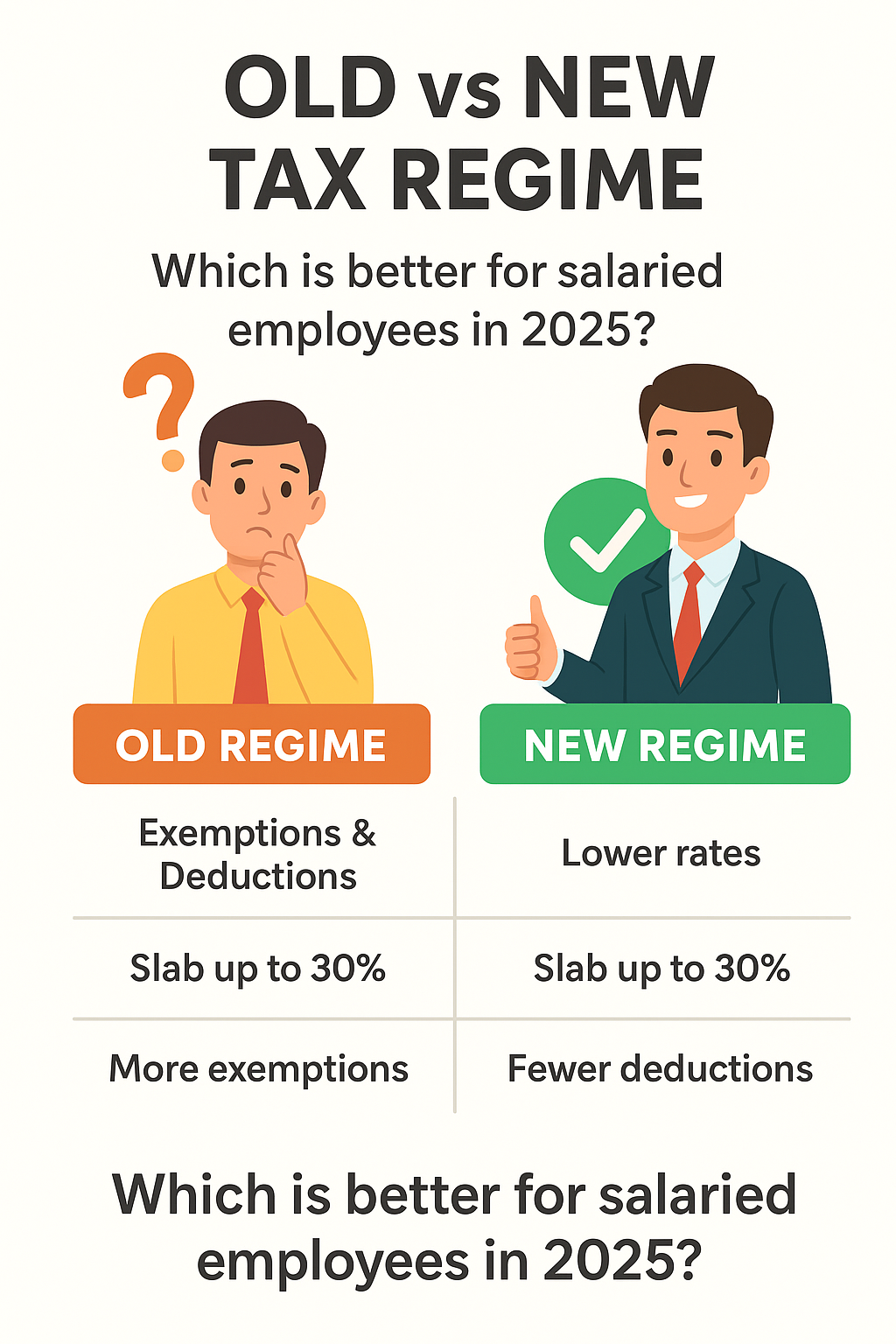Every year when tax filing season comes, one big confusion for salaried people is – Should I choose the old tax regime or the new tax regime? Old vs New Tax Regime
Since the government introduced the new regime in 2020, employees have been given two options. The Budget 2023 made the new regime default, but you can still choose the old regime while filing your ITR.
So, which one is better in 2025? Old vs New Tax Regime. Let’s understand both in simple language.
Table of Contents
1. Understanding the Old Tax Regime
The old tax regime has been around for decades. It allows you to reduce taxable income by claiming multiple exemptions and deductions.
Key Features of Old Regime:
- Popular deductions: 80C (up to ₹1.5 lakh), 80D (medical insurance), HRA, LTA, Home Loan Interest, NPS, Education Loan, Donations, etc.
- If you use these deductions, your taxable salary comes down, which reduces tax.
- But you need to keep proofs, receipts, and sometimes lock money in investments like LIC, PPF, ELSS.
Old Regime Tax Slabs (AY 2025-26):
- Up to ₹2.5 lakh → Nil
- ₹2.5–5 lakh → 5%
- ₹5–10 lakh → 20%
- Above ₹10 lakh → 30%
Example:
If your salary is ₹10 lakh and you invest ₹1.5 lakh in 80C, claim HRA, and use standard deduction, your taxable income may reduce to ₹7 lakh or even less.
2. Understanding the New Tax Regime
The new tax regime has lower tax rates but very few deductions. It is now the default option for salaried people.
Key Features of New Regime:
- Almost all exemptions like HRA, LTA, 80C are removed.
- Only Standard Deduction of ₹50,000 is allowed.
- Lower tax rates compared to old regime.
- Simple and hassle-free – no need for bills or proof.
New Regime Tax Slabs (AY 2025-26):
- Up to ₹3 lakh → Nil
- ₹3–6 lakh → 5%
- ₹6–9 lakh → 10%
- ₹9–12 lakh → 15%
- ₹12–15 lakh → 20%
- Above ₹15 lakh → 30%
Also, if your income is up to ₹7 lakh, you pay zero tax in the new regime due to rebate under Section 87A.
3. Old vs New Tax Regime – Side by Side
| Particulars | Old Regime | New Regime |
|---|---|---|
| Basic Exemption Limit | ₹2.5 lakh | ₹3 lakh |
| Standard Deduction | ₹50,000 | ₹50,000 |
| HRA, LTA, Home Loan Benefits | Available | Not Available |
| 80C, 80D, 80CCD Deductions | Available | Not Available |
| Rebate (87A) – Zero Tax Limit | Up to ₹5 lakh | Up to ₹7 lakh |
| Best For | People who claim high deductions | People with fewer deductions |
4. Which Regime is Better in 2025?
The answer depends on your salary structure and how much you invest/spend on tax-saving options.
- If you don’t invest in 80C, don’t pay rent, and don’t have a home loan → New regime is better because of lower rates.
- If you have HRA, home loan, LIC/PPF investments, medical insurance → Old regime may give you more savings.
5. Quick Comparison with Example
Case 1 – Employee without major investments:
- Salary: ₹8,00,000
- No HRA, no home loan, no 80C investment
- Standard deduction = ₹50,000
Old Regime: Taxable = ₹7,50,000 → Tax approx ₹65,000
New Regime: Taxable = ₹7,50,000 → Tax approx ₹39,000
New regime better.
Case 2 – Employee with deductions:
- Salary: ₹10,00,000
- Investments under 80C: ₹1,50,000
- Home loan interest: ₹1,50,000
- HRA exemption: ₹60,000
- Standard deduction: ₹50,000
Old Regime: Taxable = ₹6,40,000 → Tax approx ₹33,000
New Regime: Taxable = ₹9,50,000 → Tax approx ₹54,600
Old regime better.
6. Conclusion
There is no “one size fits all” answer. The new regime is simple and suits people with fewer investments or younger employees who don’t have home loans or HRA. The old regime is beneficial for people who actively use deductions like 80C, HRA, and home loan interest.
Rule of thumb:
- If deductions > ₹3 lakh → Old regime is better.
- If deductions < ₹2 lakh → New regime is better.
So, before filing ITR in 2025, calculate your tax in both regimes and then select the one that saves you the most. Smart choice = More savings in your pocket.
Contact taxgiveindia.com for filling returns in affordable prices.
